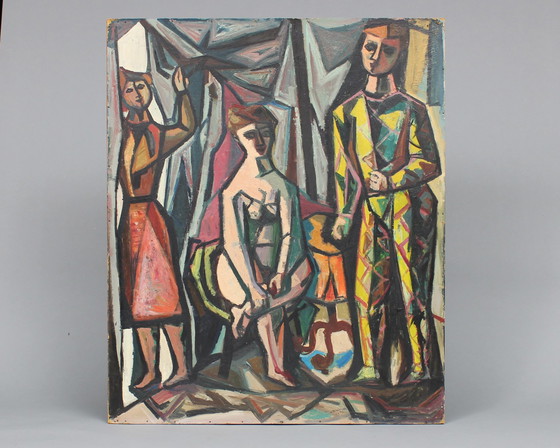Have it delivered hassle-freeBuyer protectionAll Designer items curated by WhoppahDownload the Whoppah App – get alerts & sell with ease.

Willem Boutshoorn - Circus artists in the dressing room
€1,150Bid from €950
Buy with confidence
Shop & pay safely with our Buyer ProtectionDesigner items curated by WhoppahWe only pay the seller once you have safely received the itemTrusted payment methods
About this seller
Amsterdam, NetherlandsOn Whoppah since September 2021 • 29 sales
Product description
Willem Boutshoorn (1919-2004) Oil on panel, "Circus artists in the dressing room" 1951, signed at the bottom center of the image.
Hardboard panel with tacks on a wooden frame
confirmed. Titled on the reverse.
About Wil Bouthoorn Wil Bouthoorn (1916 - 2004) was educated at the Academy of Visual Arts in The Hague. Initially his work is figurative, but subsequently has many developments in an abstract sense. Constructions and stacks of forms are created, in and through each other, figurative and non-figurative. After 1980 the figurative details disappear. Yet the work remains true to its classical origins. The human being, as a given, remains present in the work. Bouthoorn has never painted according to the issues of the day and has never joined a movement. Steadily and sometimes unnoticed for years, he worked in his studio for more than 60 years on an oeuvre that has acquired its own place in modern art. Bouthoorn has exhibited extensively, including in: Stedelijk van Abbe Museum in Eindhoven (1961), The Hague Municipal Museum (1963-1965), Stedelijk Museum in Amsterdam (1992), Singer Museum in Laren (1997). Wil Bouthoorn has received many prizes: Jacob Maris Prize (1954, 1964), Jacob Hartog Prize (1957, 1999), Ouborgh Prize of the municipality of The Hague (1992), A large number of publications have been published about Bouthoorn, including: Catalog "Paintings 1950-1991" art dealer M.L. the farmer. Catalog 1993 Stedelijk Museum Amsterdam, "Nulpunt"; text Wil Bouthoorn published by The Hague Center for Visual Arts 19….., Monograph Wil Bouthoorn, text Emilie Kröner and Lambert Tegenbosch, 2000
Wim Beeren, then director of the Stedelijk Museum From: catalog of the exhibition Paintings 1950 – 1991 in the Stedelijk Museum Amsterdam, period 10.IV.92 – 31.V.92. . " (…) Bouthoorn turned out to be just as radical as Mondrian in the recognition and appreciation of the essential painterly elements, but his attitude towards those elements is completely the opposite. Mondriaan had the artistic self-will to name the so-called autonomous color with the shape that he himself gave it. The blue that he declared autonomous was the blue that was given its shape and volume by him and that, under his direction, came to relate to other primary colors. Bouthoorn also has difficulty understanding the elements of painting as belonging to an independent organism. He also directly and ultimately determines the appearance of color and form, but every created moment (of color, structure, touch, etc.) immediately has a dictate to which the artist is 'forced' to respond. As the moments are multiplied, the independence of the painting increases and the complexity of the decisions to be made increases. It does not mean that Bouthoorn's painting is equivalent to the working process, but it does mean that the 'drama' of the creation and the interference of the active visual elements are also the subject of the end result: the painting. That also determines what Bouthoorn calls its imperfection. Yet we see that over the years Bouthoorn acquired a mastery over his material that achieved greater harmony than he perhaps expected.
Normal traces of age as to be expected from a work that is over 70 years old. The corners are slightly dented.
Normal traces of age as to be expected from a work that is over 70 years old. The corners are slightly dented.
Specifications
ConditionGoodColorsGreen, Blue, White, Red, Multi Color, Yellow, BlackMaterialWood, CanvasNumber of items1StyleVintageOrientationPortraitArt sizeMediumHeight76 cmWidth63 cm
Seller information
About this seller
Amsterdam, NetherlandsOn Whoppah since September 2021 • 29 sales






